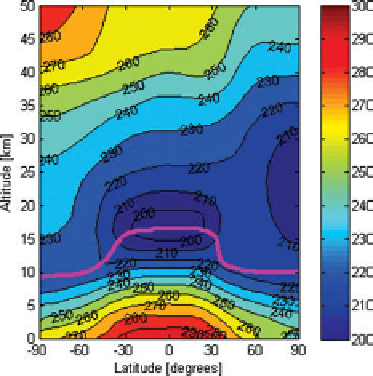Geoscience Reference
In-Depth Information
(a)
(b)
Figure 3.5.
Zonally and monthly averaged temperatures between 0 and 50 km altitude for (a) December-
January-February and (b) June-July-August. The thick solid line is the mean tropopause height for the period.
Data for the plots were compiled from the European Center for Medium Range Weather Forecasting for the
years 1969-2001; tropopause heights were determined as in Whitt et al. (2011).
The
tropopause
is the upper boundary of the tro-
posphere. Above the tropopause base, temperatures
are relatively constant with increasing height before
increasing with increasing height in the stratosphere.
Figures 3.5a and 3.5b show zonally averaged temper-
atures for a generic December-January-February and
June-July-August, respectively. A
zonally averaged
temperature is found by averaging temperatures over all
longitudes at a given latitude and altitude. Tropopause
heights are higher (15-18 km) over the Equator than
overthe poles (8-12 km). Strong vertical motions over
the Equator due to buoyancy from solar heating of the
surface and heat release during cloud formation raise
the base of the ozone layer there. Because ozone is
responsible for warming above the tropopause, pushing
ozone to greater heights over the Equator increases the
altitude at which warming begins. Over the poles, low
temperatures cause air to sink, pushing stratospheric
ozone downward as well, lowering the tropopause
height.
Temperatures at the tropopause over the Equator are
lower than they are over the poles. One reason is that the
higher base of the ozone layer over the Equator allows
tropospheric temperatures to decrease to a greater alti-
tude over the Equator than over the poles. A second
reason is that low- and midtropospheric water vapor
contents are much higher over the Equator than they
are over the poles. Water vapor absorbs thermal-IR
radiation emitted from the Earth's surface, prevent-
ing that radiation from reaching the upper troposphere,
cooling the upper troposphere over the Equator.
3.3.2. Stratosphere
The stratosphere is a large temperature inversion. The
inversion is caused by ozone, which absorbs much of the
sun's near-UV radiation and reemits thermal-IR radia-
tion, heating the stratosphere. Peak stratospheric tem-
peratures occur at the top of the stratosphere because
this is the altitude at which ozone absorbs the shortest,
thus most intense, UV wavelengths reaching the strato-
sphere (about 0.175
m). Although the ozone concen-
tration at the top of the stratosphere is low, each ozone
molecule can absorb short UV wavelengths, increas-
ing the average kinetic energy and, thus, temperature
(through Equation 3.1) of all molecules. Short UV
wavelengths do not penetrate to the lower stratosphere.
Ozone densities in the stratosphere peak at 25 to 32 km.
3.3.3. Mesosphere
Temperatures decrease with increasing altitude in the
mesosphere
for the same reason they decrease in the
background troposphere. Ozone densities are too low,
in comparison with those of oxygen and nitrogen, for
ozone absorption of UV radiation to affect the average
temperature of all molecules in the mesosphere.



Search WWH ::

Custom Search